The known Middle-aged men in Lycra (Mamils) are often described in the media, but little is known about the extent of the phenomenon.
The new We found that Mamils do exist, evidenced by increases in the proportion of middle-aged men who cycle at least weekly. However, more regular cycling and commuting to work by bicycle have not increased. The habitat of the Mamil is predominantly in affluent suburbs of major cities, often near water.
The implications Mamils provide mutual midlife support for each other and engage in challenging cycling on expensive machines, but may not contribute to increasing overall physical activity levels among adult Australians.
The middle-aged man in Lycra, or Mamil, is an emergent species. He parades along promenades in his weekend peloton plumage, having rediscovered the bicycle. Usually seen in urban environments, these creatures are particularly notable in Australia and England. They have recently become the subject of much media hype, featuring in several books, documentaries, and even a movie, and have become woven into the contemporary social fabric. Much is made of their re-engagement with exercise, and their male bonding and mutual support, as well as their tribalism and talismanic Lycra.1,2
The origins of the Mamil species are unclear, but the first descriptions, from around 2010, were characterised by middle-aged men wishing to break free from midlife crises and to obtain a new lease on life by purchasing an extravagant, slick, highly accessorised bicycle with a design fit for the Champs-Élysées. The Mamil prefers expensive carbon fibre velocipedes — Bianchi, Colnago, Pinarello, Cervélo — and likes to feel holistically integrated, at one with their cadence technology and GPS devices. In Australia, middle-aged cycling is considered “the new golf”,3 an identity symbol and language in the corporate world. The term “Mamil” entered the Oxford English Dictionary (www.oed.com) in mid-2015, defined as a “middle-aged man (esp. an avid road cyclist) who takes exercise very seriously and wears the type of clothing (made of Lycra) associated with professional sportspeople.” In the same year, the Oxford dictionary listed several other new words that resonated with the Mamil species, including eating “arancini” and “al desko”, as well as economic terms such as “flash crash” and “network marketing”.
Hundreds of media stories have been devoted to describing, understanding and satirising these weekend superheroes.1,2 Most people can recall sighting a group flashing by on the weekend (Box 1), recollections prompted by Monday morning corporate coffee discussions in which Strava segments and hill gradients are eagerly compared. Yet, if Mamils have in fact become as prevalent as commonly assumed, population scientists should be seeing increases in the proportion of middle-aged men reaching recommended levels of physical activity. Given the importance of physical activity for preventing chronic diseases, and despite the elevated body mass index of many Mamils (unpublished observational data), the Mamilian trend would be a health-enhancing social movement, not just a series of men’s sheds on wheels.
In order to assess whether this is so, we examined Australian population data trends since the pre-Mamilian era — when the world was a less colourful place and bicycles were much cheaper — in the proportions of middle-aged men who report cycling. Our secondary objectives were to examine the influence of residential socio-economic status on this phenomenon, and to compare any observed trends with reports of Mamils in the mainstream media.
Methods
We undertook a secondary analysis of previously collected de-identified data. Cycling participation rates were obtained from the national Exercise, Recreation and Sport (ERASS, 2002–2004 and 2008–2010)4 and the more recent AusPlay5 (2016) surveys. Three years’ ERASS data were pooled for each of the two earlier time periods to increase the effective sample size; Ausplay data were not pooled, as only data from late 2015 to late 2016 were available. These sport surveys provided representative national data on the proportion of people who reported any cycling, cycling at least 52 times (ie, at least once a week), or cycling at least 156 times (ie, at least 3 times per week) during the preceding 12 months. Data from the three surveys were approximately matched to reflect the situation at three time points in the past decade, starting with a period (2002–2004) that was definitely pre-Mamilian.
Data on the proportion of employed adults cycling to work (2006, 2010, 2014) were obtained from the New South Wales Adult Population Health Survey.6 Data for journeys to work containing the word “bicycle” were obtained from the Australian censuses of 2006, 2011 and 2016 using the TableBuilder module (http://www.abs.gov.au/websitedbs/censushome.nsf/home/tablebuilder).
Middle-aged men were defined as those aged 45–64 years, although earlier definitions of Mamil included younger men (“young Mamils”, 25–44 years old). Socio-economic status of residential address was according to the Australian Bureau of Statistics 2016 Index of Relative Socio-economic Disadvantage (IRSD);7 national percentiles were grouped into quartiles (quartile 1, most disadvantaged). Proportions (with 95% confidence intervals [CIs]) were estimated with the SAS 9.4 (SAS Institute) survey analysis procedures, accounting for the complex designs of each survey.
Trends in appearances of the term “Mamil*” in major print media in England, Australia, and elsewhere, excluding mentions by industry and retail outlets, were assessed by examining records in the Factiva media database (https://www.dowjones.com/products/factiva) from the earliest reported use of the term.
Ethics approval
The Australian Sports Commission (now Sport Australia) provided de-identified Ausplay and ERASS data; the NSW Ministry of Health provided raw data from their Population Health Survey. Each agency approved our analyses, subject to agreements regarding anonymisation and confidentiality. Formal ethics approval was therefore not required for our secondary analysis.
Results
In the sequential national sport surveys (ERASS and Ausplay), cycling during the preceding 12 months was reported by 11.1% of middle-aged men (95% CI, 10.0–12.1%; 724 men) during 2002–04, increasing to 15.2% (95% CI, 14.3–16.2%; 1522 men) during 2008–2010 and 20.8% (95% CI, 19.2–22.4%; 713 men) in 2016; cycling at least once a week increased from 6.2% (95% CI, 5.5–7.0%; 437 riders), to 8.8% (95% CI, 8.1–9.6%; 899 riders) and 13.2% (95% CI, 11.9–14.5%; 462 riders). The proportions of people aged 45–64 years who reported cycling at least once a year or at least once a week increased to a greater extent for men than for women, while the proportions for younger adults (25–44 years) were similar at all three time points (Box 2, Box 3). The proportions of middle-aged men reporting cycling at least three times a week increased from 2.8% (95% CI, 2.2–3.3%; 191 riders) during 2002–2004 to 3.9% (95% CI, 3.4–4.5%; 410 riders) during 2008–2010 and 6.5% (95% CI, 5.6–7.5%; 227 riders) in 2016, and among younger men from 3.7% (95% CI, 3.1–4.2%; 287 riders) to 4.1% (95% CI, 3.5–4.7%; 356 riders) and 5.0% (95% CI, 4.1–5.9%; 131 riders).
According to New South Wales Population Health Survey data, the proportions of 45–64-year-old men cycling for commuting purposes were similar in 2006, the earliest survey (1.1%; 95% CI, 0.5–1.7%; 13 riders), and 2014 (1.3%, 95% CI, 0.6–2.0%; 19 riders). The proportions were higher among 25–44-year-old men (2006, 2.5% [95% CI, 0.8–4.1%]; 14 riders; 2014, 2.8% [95% CI, 1.5–4.1%]; 28 riders, but also similar in both surveys. That is, active commuting to work by men in these demographic groups had not increased between 2006 and 2014 (Box 4).
Data from Australian censuses similarly indicated that the proportion of middle-aged men who cycled to work on the day of the census has not increased. The overall prevalence of active commuting among middle-aged men increased slightly from 1.1% in 2006 to 1.4% in 2016; the rates for middle-aged women were much smaller, but had also increased mildly (Box 5).
According to the ERASS and Ausplay data, the proportions of 25–44- and 45–64-year-old men who cycled at least once a week during the previous year varied strikingly by socio-economic status. The differences increased with time for both age groups, and were much more marked during 2008–2010 and 2016 than during 2002–2004 (Box 6). The proportion of middle-aged men living in suburbs in the highest socio-economic status quartile who cycled at least weekly more than doubled over the 14-year study period, from 7.5% (95% CI, 6.1–9.0%; 181 riders) to 17.4% (95% CI, 14.9–19.8%; 219 riders). The increasing socio-economic differential suggests that Mamils and young Mamils are a rising phenomenon largely confined to affluent Australia, typically areas along the coastline.8
Factiva data indicated a marked increase in media reporting on Mamils since 2010, with a peak in 2014 (Box 7). Overall, there were about 150 references to “Mamils” each year in the major print media, mostly in the United Kingdom (60% of mentions) or Australia (31%); sightings were also reported in Ireland, France, Canada, and New Zealand.
Discussion
We found that cycling by middle-aged men has increased since 2002–2004, supporting reports of the growth of the Mamil species. However, most are weekend superheroes and do not cycle to work during the week. The habitats of Mamils are generally affluent urban environments, often near the water, where Mamils meet in groups to channel their inner Cadel Evans in their technology-assisted quest to ride as fast as they can to the most distant coffee shop. This activity may provide mutual social support and increase physical activity in this select group, but we also found that they probably constitute a small subpopulation of middle-aged men, and that the Mamil effect is not generalised across their age group; despite increases in the number of bicycles sold, the proportion of people who cycle has not grown substantially.9
Overall, total physical activity among middle-aged adults has increased only minimally over the past 22 years; slight increases among 45–54-year-old people have been noted, but they are more marked for women and in those in the highest socio-economic status quintile.10 Although these increases might be attributed to the rise of the Mamils, they seem to have been driven more strongly by increased walking.11
Further, bicycle sales and the bicycle industry have grown much more rapidly than has the number of cyclists.9 More bicycles are sold than motor vehicles, but many thousands of the bikes bought across Australia each year are seldom ridden.10 Both the average cost of bicycles and the number of high end bicycles sold have increased dramatically; Mamils may keep some bike shops open even with infrequent but costly veloci-purchases.
Concurrent trends in newspaper reporting recorded in the Factiva database corroborate our other findings. However, the direction of causality cannot be determined: did increased media reporting entice the Mamils out of their hidey holes, or did the dazzling Mamils attract the interest of the media?
Mental health benefits realised by participation in collective Mamilism were described in a qualitative study of middle-aged male cyclists, including increased physical challenge, increased sense of mastery, and group bonding while enjoying the outdoors.12 Some authors have reported potential adverse effects; for example, obsessive Mamils, prone to prolonged saddle time, are at increased risk of urodynamic problems, including prostatitis and erectile dysfunction.13
The vision of the sartorially elegant Mamil is not new: the proto-Mamilian attributes of male vanity, competitiveness, and cycling accessories and apparel were all evident 120 years ago, as Banjo Patterson reflected during the first mass cycling craze in the 1890s14 (Box 8). More recent Mamilian sightings seem to be concentrated in England and Australia, as the concept of the middle-aged man emulating riders in the La Vuelta and La Tour has been embedded in European culture for decades.
The example set by these avant-garde peloton leaders may foster stronger bonds between men and have positive effects on their wellbeing and morale, as Mamils are having a wheelie good time. However, they are more frequently spotted in coastal and inner western Sydney, central and northern Canberra, inner Melbourne, and Claremont/Nedlands in Perth; the affluent Sydney suburb of Mosman allegedly has “more MAMILs per square metre than the Tour de France”.15 It is rare to see them except on weekends or outside their usual habitats. It would be nice for them to cross the sex divide, to seek out the rarely glimpsed Greater Mawil, the female counterpart of the Mamil, as well as the very rare OSAC (Outer Suburban Active Cyclist), perhaps discovering that species of non-Lycra-clad riders of all ages also exist. If so, we could peddle better health by more of us pedalling regularly.
Box 1 – Three seldom spotted mountain biking middle-aged men in Lycra (Mamils), and a rare middle-aged woman in Lycra (Mawil)
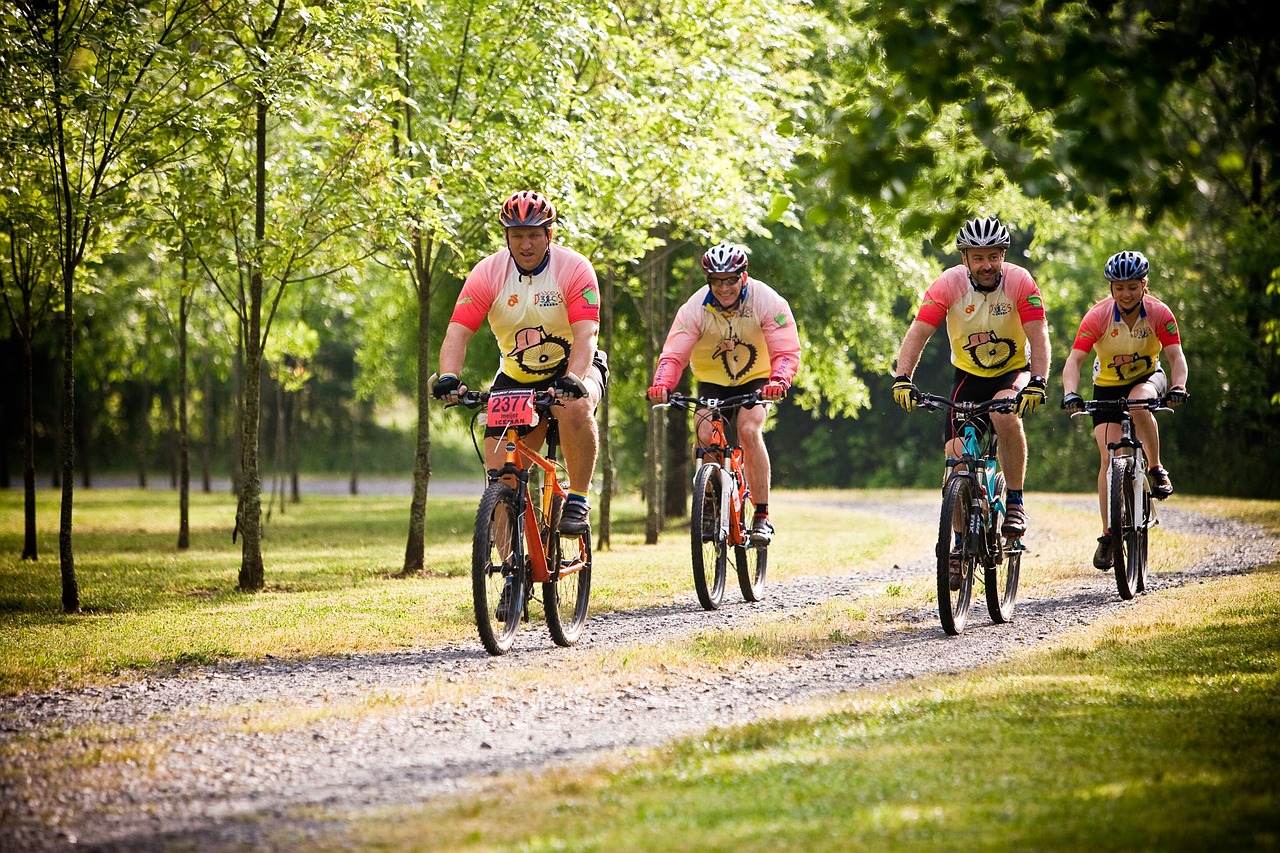
Source: https://pixabay.com/en/mountain-bikes-cycling-bike-766172.
Box 2 – Estimated proportions of adults who cycled at least once during the preceding year according to Exercise, Recreation and Sport (ERASS; 2002–2004, 2008–2010) and Ausplay survey data (2016), by age group and sex
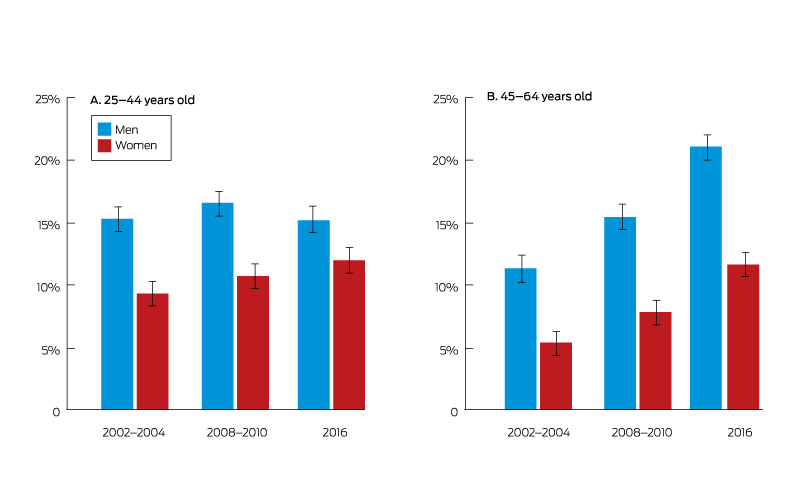
Box 3 – Estimated proportions of adults who cycled at least once a week during the preceding year according to Exercise, Recreation and Sport (ERASS; 2002–2004, 2008–2010) and Ausplay survey data (2016), by age group and sex
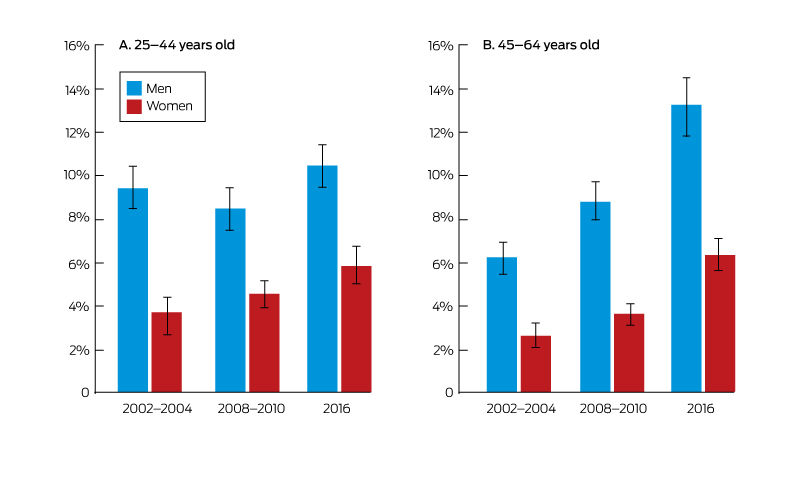
Box 4 – Estimated proportions of adults who commute to work by bicycle according to New South Wales Population Health survey data (2006, 2011, 2014), by age group and sex
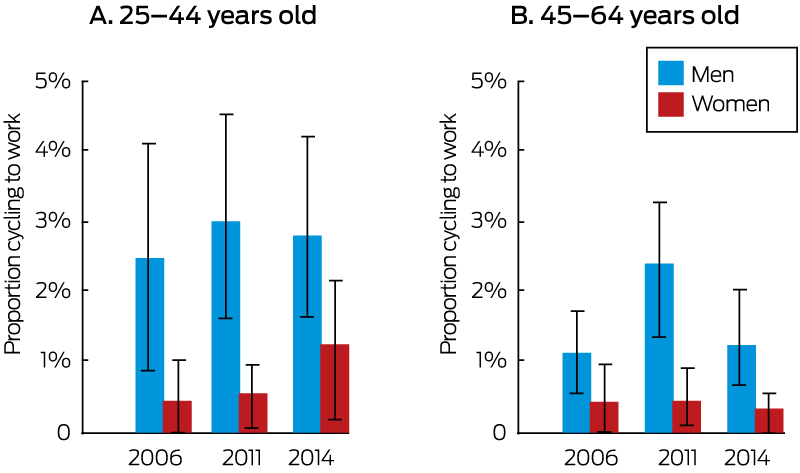
Box 5 – Proportions of adults who commuted to work by bicycle according to Australian Bureau of Statistics census data (2006, 2011, 2016), by age group and sex
|
Rode to work on day of census |
Census year |
||||||||||||||
|
2006 |
2011 |
2016 |
|||||||||||||
|
|
|||||||||||||||
|
Men: all adults |
75 753 (1.0%) |
89 365 (1.1%) |
90 574 (1.0%) |
||||||||||||
|
Men: 40–59 years old |
29 348 (1.1%) |
37 439 (1.3%) |
40 761 (1.3%) |
||||||||||||
|
Women: all adults |
19 900 (0.3%) |
27 060 (0.3%) |
31 810 (0.3%) |
||||||||||||
|
Women: 40–59 years old |
6932 (0.3%) |
9848 (0.3%) |
12 317 (0.4%) |
||||||||||||
|
|
|||||||||||||||
|
|
|||||||||||||||
Box 6 – Proportions of men who cycled during the preceding year at least once a week, according to Exercise, Recreation and Sport (ERASS; 2002–2004, 2008–2010) and Ausplay survey data (2016), by age group and socio-economic status of residence*
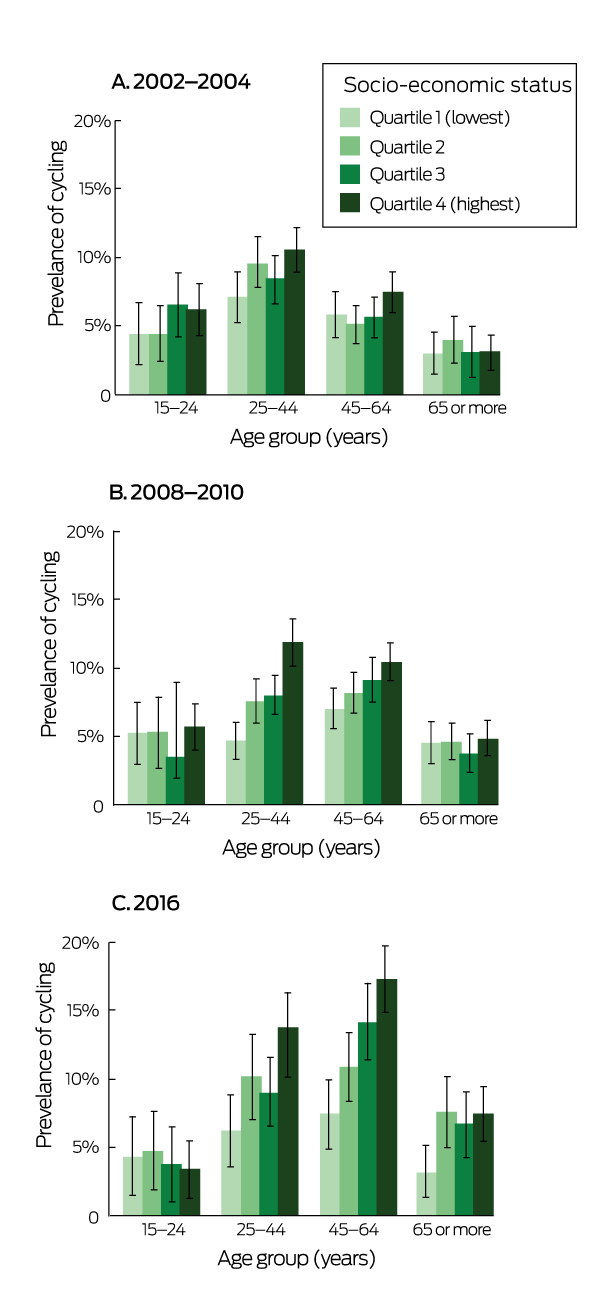
* Index of Relative Socio-economic Disadvantage (IRSD) quartiles: first quartile is most disadvantaged, fourth quartile is least disadvantaged.
Box 7 – References to “Mamil” or “Mamils” in print media (newspaper) sources in the Factiva database
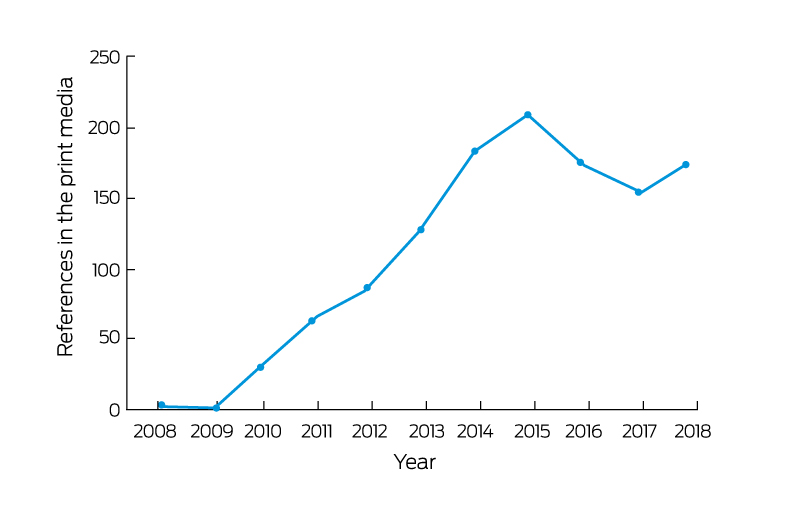
Box 8 – Mulga Bill’s bicycle, by Banjo Paterson, 1896 (first verse)12
'Twas Mulga Bill, from Eaglehawk, that caught the cycling craze.He turned away the good old horse that served him many days.
He dressed himself in cycling clothes, resplendent to be seen.
He hurried off to town and bought a shining new machine;
And as he wheeled it through the door, with air of lordly pride,
The grinning shop assistant said, “Excuse me, can you ride?”
- Adrian E Bauman1
- Katrina Blazek1,2
- Lindsey Reece1
- William Bellew1
- 1 University of Sydney, Sydney, NSW
- 2 New South Wales Ministry of Health, Sydney, NSW
This work was completed while Katrina Blazek was employed as a trainee in the NSW Biostatistics Training Program funded by the NSW Ministry of Health. She undertook this work while based at the Prevention Research Collaboration, Charles Perkins Centre at the School of Public Health, the University of Sydney. We thank several (medically) “specialised” Mamils who provided anonymous source material.
Between us, we own up to having four functional bicycles, with a total value of no more than $1200, substantially less than that of a single set of the Mavic Aksium wheels often seen on Mamilian bicycles.
- 1. Merhi K. The life of a MAMIL: it's not just about the Lycra. Sydney Morning Herald, 26 Jan 2018. https://www.smh.com.au/lifestyle/the-life-of-a-mamil-its-not-just-about-the-lycra-20180117-h0jnuh.html (viewed Oct 2018).
- 2. Seaton M. The humble Mamil: why we need “middle-aged men in Lycra”. The Guardian (London), 11 Sept 2012. https://www.theguardian.com/commentisfree/2012/sep/11/mamil-middle-aged-men-in-lycra (viewed Oct 2018).
- 3. Knight A. Cycling is the new golf. Sydney Morning Herald, 8 Apr 2014. https://www.smh.com.au/business/small-business/cycling-is-the-new-golf-20140408-369qh.html (viewed Oct 2018).
- 4. Australian Sports Commission. Exercise, recreation and sport survey: ERASS annual reports. https://web.archive.org/web/20180313164639/https://www.ausport.gov.au/information/casro/ERASS (viewed Oct 2018).
- 5. Australian Sports Commission. AusPlay: participation data for the sport sector. Summary of key national findings, October 2015 to September 2016 data. Dec 2016. https://www.ausport.gov.au/news/asc_news?a=653871 (viewed Oct 2018).
- 6. New South Wales Ministry of Health. Adult population health survey. https://www.health.nsw.gov.au/surveys/adult/Pages/default.aspx (viewed Oct 2018).
- 7. Australian Bureau of Statistics. 2033.0.55.001. Census of population and housing: Socio-Economic Indexes for Areas (SEIFA), Australia, 2016. IRSD. Mar 2018. http://www.abs.gov.au/ausstats/abs@.nsf/Lookup/by%20Subject/2033.0.55.001∼2016∼Main%20Features∼IRSD∼19 (viewed Oct 2018).
- 8. Bauman A, Smith B, Stoker L, et al. Geographical influences upon physical activity participation: evidence of a “coastal effect”. Aust N Z J Public Health 1999; 23:322-324.
- 9. Bauman A, Merom D, Rissel C. “Where have all the bicycles gone?” Are bicycle sales in Australia translated into health-enhancing levels of bicycle usage? Prev Med 2012; 54: 145-147.
- 10. Chau J, Chey T, Burks-Young S, et al. Trends in prevalence of leisure time physical activity and inactivity: results from Australian National Health Surveys 1989 to 2011. Aust N Z J Public Health 2017; 41: 617-624.
- 11. Merom D, Ding D, Corpuz G, Bauman A. Walking in Sydney: trends in prevalence by geographic areas using information from transport and health surveillance systems. J Transp Health 2015; 2: 350-359.
- 12. Glackin OF, Beale JT. “The world is best experienced at 18 mph”. The psychological wellbeing effects of cycling in the countryside: an interpretative phenomenological analysis. Qual Res Sport Exercise Health 2018; 10: 32-46.
- 13. Cassels A. Cycling and the middle-aged man: more urodynamics than aerodynamics? CMAJ 2014; 186: 1184.
- 14. Paterson AB. Mulga Bill’s bicycle. Sydney Mail, 25 July 1896, p. 183. https://trove.nla.gov.au/newspaper/article/163782289?browse=ndp%3Abrowse%2Ftitle%2FS%2Ftitle%2F698%2F1896%2F07%2F25%2Fpage%2F16794964%2Farticle%2F163782289 (viewed Oct 2018).
- 15. Purcell C. Life behind the latte line: not everyone in Mosman is wealthy. Sydney Morning Herald 28 Mar 2018. https://www.smh.com.au/national/life-behind-the-latte-line-not-everyone-in-mosman-is-wealthy-20180328-p4z6p0.html (viewed Oct 2018).





Abstract
Background: The Mamil (middle-aged man in Lycra) appears to be an emergent cycling-focused species.
Objectives: To explore the nature and distribution of the Mamilian species; to determine whether rates of cycling by middle-aged men in Australia have changed since the pre-Mamilian era.
Setting: Secondary analysis of representative population-based datasets. National sport participation data from the Exercise, Recreation and Sport (2002–2004, 2008–2010) and Ausplay surveys (2016) were analysed to assess trends in recreational and exercise-related cycling, including by middle-aged men (45–64 years of age). Data from New South Wales Population Health Surveys (2006, 2010, 2014) and Australian censuses (2006, 2011, 2014) were analysed to assess trends in cycling to work.
Main outcome measures: Cycling participation rates (at least once or at least once a week in the past 12 months); rates of cycling to work.
Results: The proportion of middle-aged men who cycled for exercise or recreational purposes at least once a week during the previous year increased from 6.2% (95% CI, 5.5–7.0%) during 2002–2004 to 13.2% (95% CI, 11.9–14.6%) in 2016. The prevalence of Mamils in the most affluent residential areas has more than doubled since 2002–2004, and is twice as high as in the least advantaged locations. Media reports of “Mamils” corroborate these temporal trends.
Discussion: Mamils in Australia are socially graded, and also grade themselves according to bicycle-related expenditure and hill gradients overcome. They often form cohesive and supportive groups, but may not reflect a population-wide social movement to increase physical activity among adult Australians.